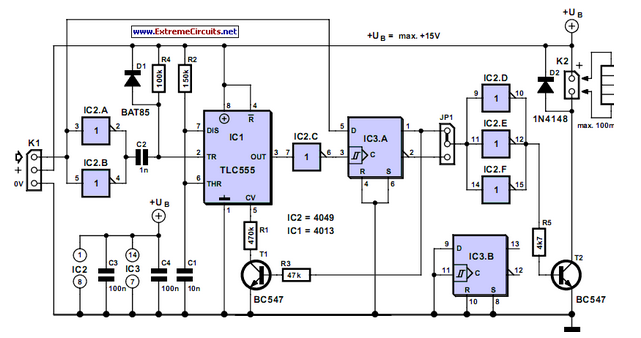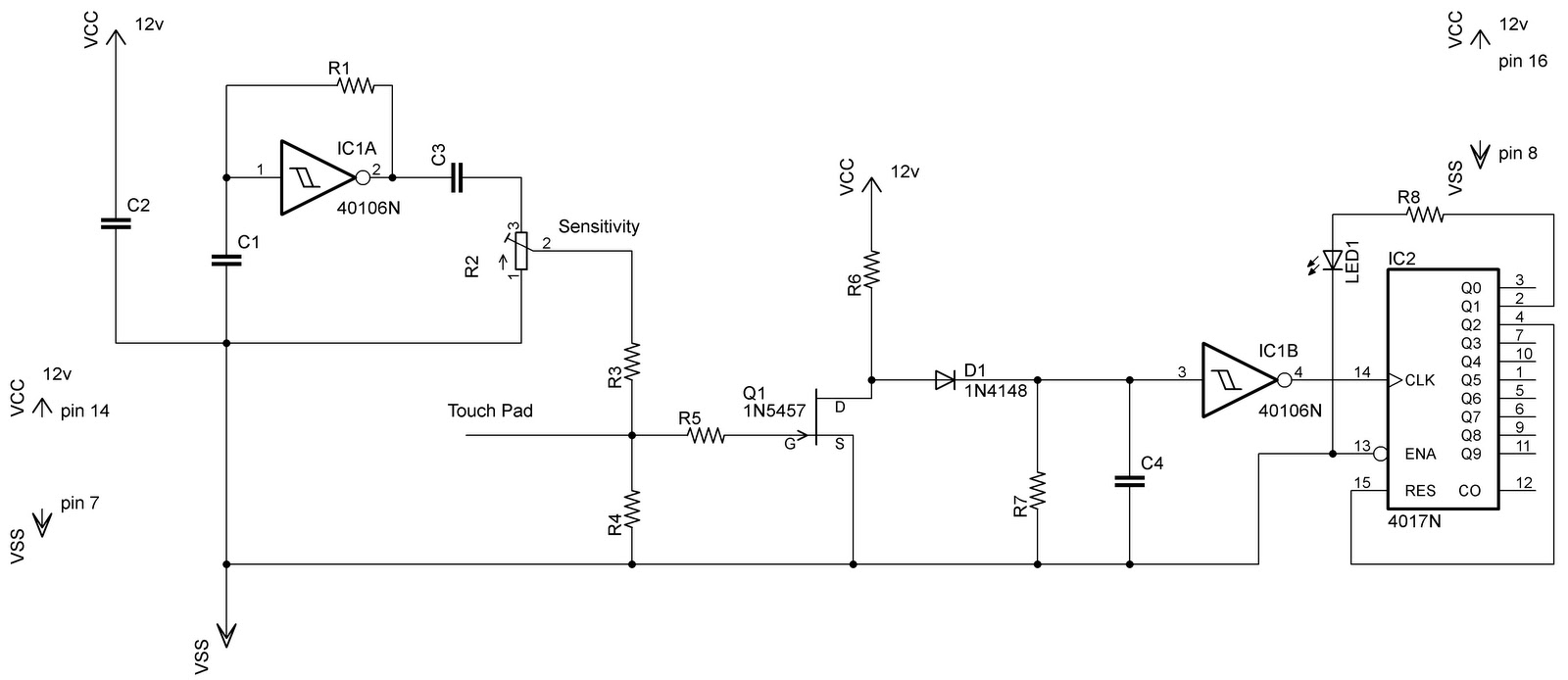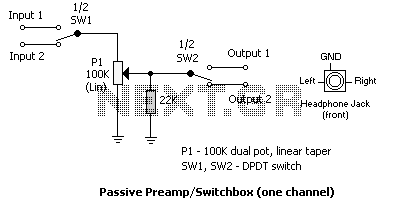
Overheat Detector Alarm Switch

The circuit utilizes a precision integrated temperature sensor, the LM35 (IC1), which provides a linear and directly proportional output in millivolts over a temperature range of 0 to +155 degrees Celsius. This sensor can be incorporated into fire smoke detectors, but it is not intended for use as a home fire alarm system. The output from the LM35 is connected to the non-inverting input of a comparator built around a CA3130 operational amplifier (IC2). A voltage divider network consisting of resistor R3 and potentiometer P1 sets the threshold voltage at the inverting input of the op-amp. This threshold voltage establishes the adjustable temperature trip level that activates the circuit. When the measured temperature surpasses the user-defined level, the comparator outputs a high signal of approximately 2.2 volts, which forward-biases transistor T1. This action also activates transistor T2, providing sufficient voltage to the oscillator circuit centered around IC3. The 555 timer configured in astable mode directly drives an active piezoelectric buzzer (Bz1) to emit a loud alert. The components R7, R8, and capacitor C4 dictate the on/off rhythm of the sound produced. A transistor-based relay driver may be activated from the emitter of T1 (TP1). Additionally, substituting the piezo sounder with an appropriate relay allows for the control of high-power flashers, sirens, or horns operating on the AC mains supply.
The LM35 temperature sensor is known for its precision and linearity, which makes it suitable for applications where accurate temperature measurement is crucial. The output voltage of the LM35 increases by 10 mV for every degree Celsius increase in temperature, facilitating straightforward interpretation of the temperature readings. The CA3130 op-amp is selected for its high input impedance and low offset voltage, ensuring that the comparator functions effectively without loading the sensor output.
The voltage divider formed by R3 and P1 allows for easy adjustment of the trip point. The potentiometer P1 provides flexibility in setting the desired temperature threshold, enabling customization for various applications. When the temperature exceeds the set threshold, the comparator's output transitions to a high state, activating T1. This transistor acts as a switch, allowing current to flow through T2, which in turn powers the oscillator circuit.
The 555 timer, configured in astable mode, generates a square wave output that drives the piezoelectric buzzer. The frequency of this output is determined by the values of resistors R7, R8, and capacitor C4, which together set the timing characteristics of the sound alert. This design choice ensures that the alert is both audible and attention-grabbing.
For applications requiring the control of larger loads, the circuit can be modified to drive a relay. By replacing the piezo sounder with a relay, the circuit can control high-power devices such as flashers, sirens, or horns, making it suitable for more demanding alerting systems. The relay driver circuit can effectively isolate the low-power control signals from the high-power loads, ensuring safe operation and preventing damage to the components.The circuit is a precision integrated temperature sensor type LM35 (IC1), which provides an accurately linear and directly proportional output in mV, over the zero to +155 degrees C temperature range. This can be used as part of fire smoke detectors but do not use it as a home fire alarm system. Here the output of the LM35 is applied to the non-inverting input of a comparator wired around a CA3130 opamp (IC2). A voltage divider network R3-P1 sets the threshold voltage, at the inverting input of the opamp. The threshold voltage determines the adjustable temperature trip level at which the circuit is activated. When the measured temperature exceeds the user-defined level, the comparator pulls its output High to approx.
2. 2 V causing transistor T1 to be forward biased instantly. T2 is also switched on, supplying the oscillator circuit around IC3 with sufficient voltage to start working. The 555 set up in astable mode directly drives active piezoelectric buzzer Bz1 to raise a loud alert.
Components R7, R8 and C4 determine the on/off rhythm of the sounder. A transistor based relay driver may be driven off the emitter of T1 (TP1). Similarly, replacing the piezo sounder with a suitable relay allows switching of high-power flashers, sirens or horns working on the AC mains supply. 🔗 External reference
The LM35 temperature sensor is known for its precision and linearity, which makes it suitable for applications where accurate temperature measurement is crucial. The output voltage of the LM35 increases by 10 mV for every degree Celsius increase in temperature, facilitating straightforward interpretation of the temperature readings. The CA3130 op-amp is selected for its high input impedance and low offset voltage, ensuring that the comparator functions effectively without loading the sensor output.
The voltage divider formed by R3 and P1 allows for easy adjustment of the trip point. The potentiometer P1 provides flexibility in setting the desired temperature threshold, enabling customization for various applications. When the temperature exceeds the set threshold, the comparator's output transitions to a high state, activating T1. This transistor acts as a switch, allowing current to flow through T2, which in turn powers the oscillator circuit.
The 555 timer, configured in astable mode, generates a square wave output that drives the piezoelectric buzzer. The frequency of this output is determined by the values of resistors R7, R8, and capacitor C4, which together set the timing characteristics of the sound alert. This design choice ensures that the alert is both audible and attention-grabbing.
For applications requiring the control of larger loads, the circuit can be modified to drive a relay. By replacing the piezo sounder with a relay, the circuit can control high-power devices such as flashers, sirens, or horns, making it suitable for more demanding alerting systems. The relay driver circuit can effectively isolate the low-power control signals from the high-power loads, ensuring safe operation and preventing damage to the components.The circuit is a precision integrated temperature sensor type LM35 (IC1), which provides an accurately linear and directly proportional output in mV, over the zero to +155 degrees C temperature range. This can be used as part of fire smoke detectors but do not use it as a home fire alarm system. Here the output of the LM35 is applied to the non-inverting input of a comparator wired around a CA3130 opamp (IC2). A voltage divider network R3-P1 sets the threshold voltage, at the inverting input of the opamp. The threshold voltage determines the adjustable temperature trip level at which the circuit is activated. When the measured temperature exceeds the user-defined level, the comparator pulls its output High to approx.
2. 2 V causing transistor T1 to be forward biased instantly. T2 is also switched on, supplying the oscillator circuit around IC3 with sufficient voltage to start working. The 555 set up in astable mode directly drives active piezoelectric buzzer Bz1 to raise a loud alert.
Components R7, R8 and C4 determine the on/off rhythm of the sounder. A transistor based relay driver may be driven off the emitter of T1 (TP1). Similarly, replacing the piezo sounder with a suitable relay allows switching of high-power flashers, sirens or horns working on the AC mains supply. 🔗 External reference





